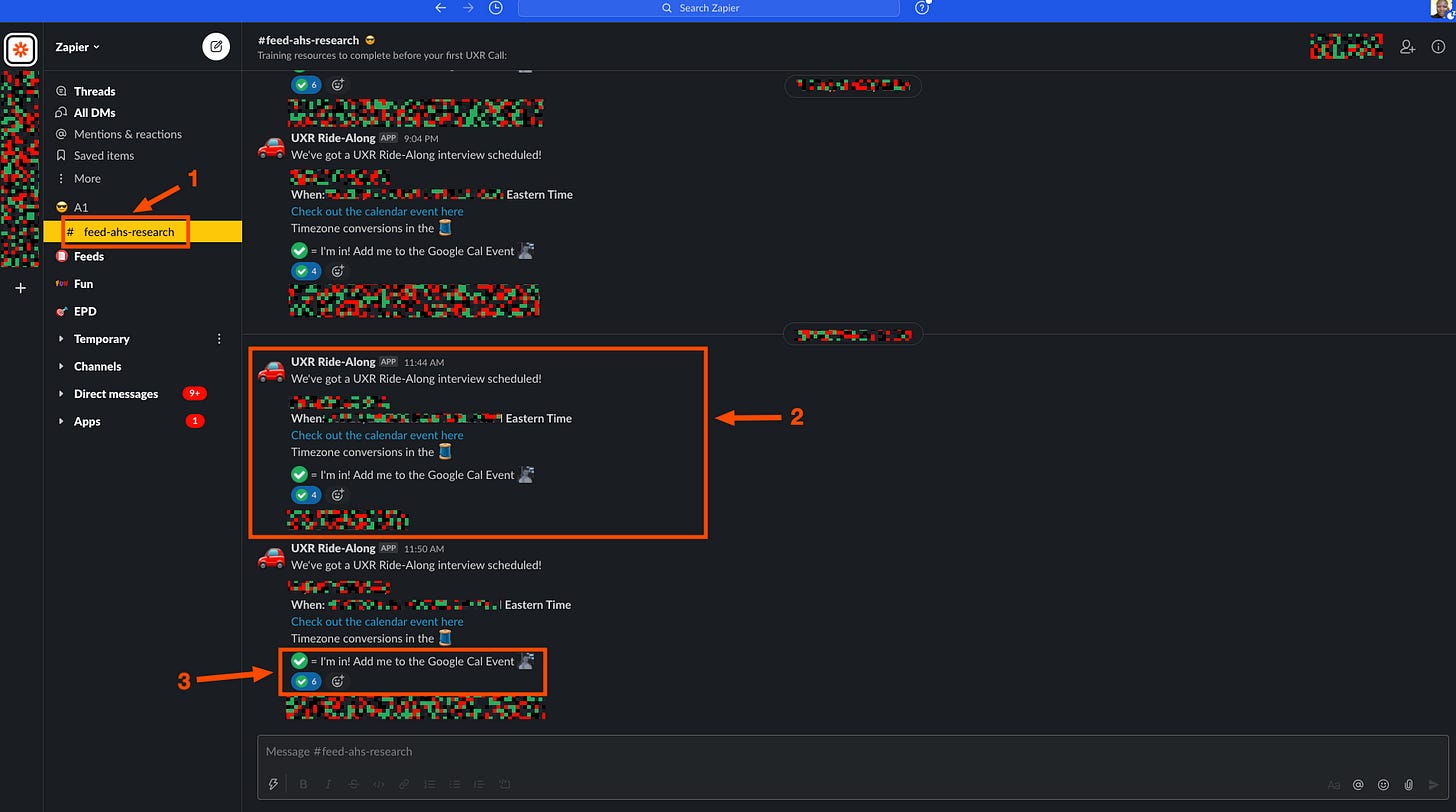How We Set Up Research Ride-Alongs at Zapier
Before today’s post…🥁
If you're hiring for the Research Ops position at your company, Kim Porter (Research Ops at BT) has some handy tips for how to frame that role. Have a listen below! 🎧
All Hands Support (AHS) has been a practice at Zapier since the company launched. Each teammate spends some time doing customer support every week. This enables our team to:
Never lose sight of the problems that our customers encounter
Fix some of the issues that our customers share with us
Last year, as the company grew larger, we decided to adjust AHS to provide more customer interaction options.
Increasing Exposure Hours
In rethinking our AHS setup, we considered how to expose more people in our team to the everyday use of Zapier.
The more exposure our team has to people who use our product — especially when that exposure is well crafted — the more likely we are to understand the real problems they encounter. This isn’t rocket science, but it’s also not common practice.
We decided to experiment with AHS research ride-along sessions (ride-alongs) to give our team more close contact with Zapier users.
Setting Up Ride-Alongs
Ride-alongs allow anyone across the company to join in on a research session.
These sessions are remote user interviews with new customers where we ask about their:
Everyday work
Journey to using Zapier
Current automated workflows (Zaps)
Following the session, we run a short debrief to share our top observations.
Setting up ride-alongs to make them accessible for our employees across the world was a challenging task. I started three tasks in mind:
Create a light training session to give teammates additional context about UXR.
Set up an easy flow for teammates to find and join ride-along sessions.
Find a tool that facilitated an ideal observer and participant experience.
Training
For people with experience in UX, user research seems perfectly normal. However, many outside of the UX field think research is confusing and intimidating.
If you’re a marketer, recruiter, accountant, or even a designer with little research experience, it’s easy to shy away from this practice. I didn’t want unfamiliarity with UXR to be a barrier that prevented participation in ride-alongs, so I created a ‘UXR 101’ training session.
Before joining a ride-along, we require teammates to go through this 45-minute interactive session to learn research basics. Teammates who cannot attend the live session (usually due to large time zone differences) can go through the self-serve UXR 101 class.
This training aims to give teammates enough context and knowledge to observe a research session comfortably. It’s basic, but you’d be surprised at how helpful the basics can be, even for people who previously run research.
Discovery
Everyone at our company is busy. They’re less likely to join ride-alongs if participation is cumbersome or complicated. I want to maximize the chance that everyone who shows an interest in ride-alongs can discover and join sessions.
This process went through several iterations, but here’s the current flow.
Teammates who are interested in ride-alongs join the ride-along Slack channel.
An automated alert appears in the channel when a call is scheduled. This alert (and threaded messages) includes details about the call and information for first-time ride-along participants.
When a teammate reacts to the alert with the circle-check icon, they automatically receive an invite to the ride-along session.
Everyone attending the ride-along receives a reminder thirty minutes before the session with details about joining the call.
We simplified this flow by using Zapier to automate the entire process.
All that teammates need to do is:
React
Click a link at the session start time
It removes nearly all the friction that prevents a willing teammate from finding and joining a session.
Tooling
From the start, we have hoped to have lots of teammates join the ride-along sessions. I wanted to set up tooling that enabled:
An excellent participant experience no matter the number of observers. The last thing a customer wants is to join a call and view a sea Zapier employees!
A stellar observer experience. Teammates can be hesitant to join sessions because they don’t know what to expect and don’t want to interact with customers.
At Zapier, we’ve long used Zoom for remote user interviews, but it’s not easy to set up a separate and comfortable participant and observer experience.
After researching and trying out different tools, we settled on Lookback.
Lookback LiveShare provides a separate observer experience with areas for text chatting and note-taking. Participants cannot see observers, and that’s a big deal for both parties:
Observers (Zapier teammates) never have to worry about their mic or background noise; they can focus on learning.
Participants only see the session moderator and can focus on questions or tasks. Of course, we always inform participants that observers are on the call. We do this both before and at the start of the session.
Lookback has allowed us to create a ride-along experience that’s different from watching a session recording. Our team can interact, ask questions, share answers to user questions, and more.
What We’ve Learned So Far
I’ve shared a lot of information here! 😅
In a future post, I’ll outline the critical lessons we’ve learned nearly one year into ride-alongs.
Over To You
Have you run a similar program? What worked or failed?
I’d love to learn from your experiences. Please share in the comments or via email. 😀
Sign up to receive future posts via email. 📬
Photo by Jakob Owens on Unsplash






